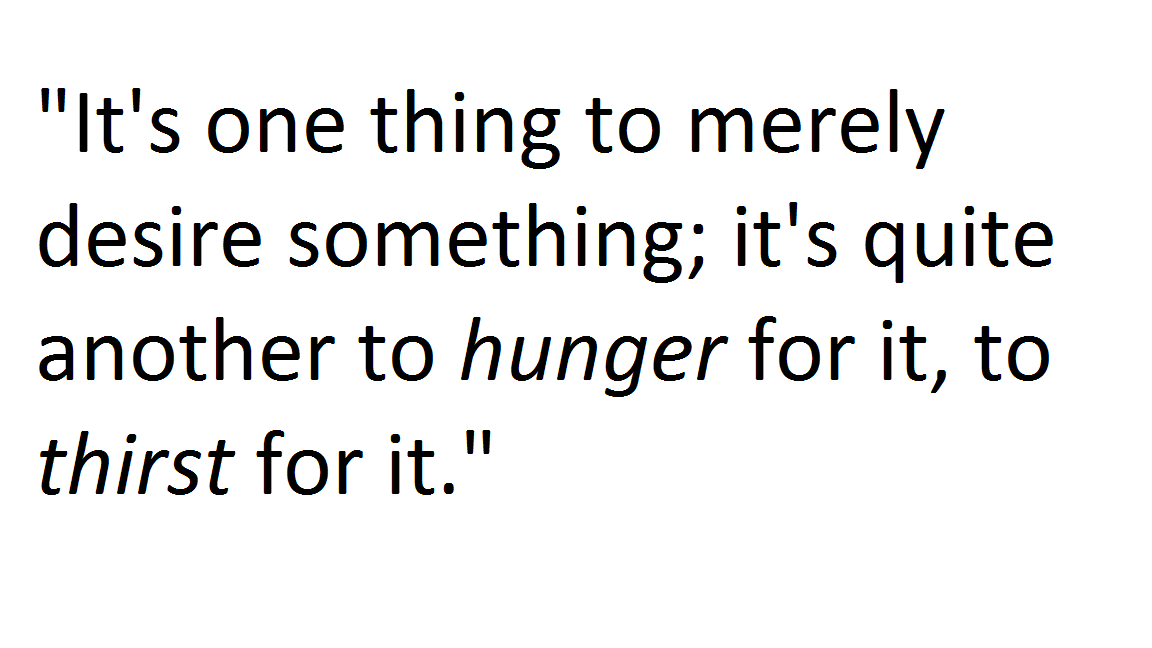Blessed are those who hunger and thirst for righteousness, for they shall be satisfied. (Mt 5:6)
It is not enough that we desire righteousness, unless we also suffer hunger for it, by which expression we may understand that we are never righteous enough, but always hunger after works of righteousness. (St. Jerome)
It’s striking that our Lord uses such bodily imagery to describe the desire for righteousness here—hunger and thirst are decidedly physical phenomena, often characterized by grumbling of the stomach or dryness of the throat, whereas righteousness is less obviously physical. But as St. Jerome (d. 420) points out, it’s one thing to merely desire something; it’s quite another to hunger for it, to thirst for it. The physicality of Jesus’ language here intensifies his meaning. And indeed, if it simply read, “Blessed are those who want righteousness, for they shall eventually get it,” something of its meaning would be lost.
 Now, when our Lord talks about hungering and thirsting for righteousness, he is of course speaking metaphorically: righteousness isn’t something we can chew on or sip, eat or drink. But there is a deeper meaning to his words. Again, it’s significant that Jesus should resort to physical imagery, that we should hear these kinds of words from our Lord’s lips. After all, that God could even have lips—that the immaterial Word of God would become man, assuming a human nature and therefore a material human body—is astonishing. Jesus himself, having become a man like us in all things but sin, experienced hunger and thirst like us. By using this kind of language he invites us to hunger for righteousness as if starving and to make righteousness our sustenance.
Now, when our Lord talks about hungering and thirsting for righteousness, he is of course speaking metaphorically: righteousness isn’t something we can chew on or sip, eat or drink. But there is a deeper meaning to his words. Again, it’s significant that Jesus should resort to physical imagery, that we should hear these kinds of words from our Lord’s lips. After all, that God could even have lips—that the immaterial Word of God would become man, assuming a human nature and therefore a material human body—is astonishing. Jesus himself, having become a man like us in all things but sin, experienced hunger and thirst like us. By using this kind of language he invites us to hunger for righteousness as if starving and to make righteousness our sustenance.
Another reason the physical imagery is important is the fact that there is a real physicality to our faith. In addition to the Incarnation, we also have sacramentals, which can dispose us to receive the grace of the sacraments (cf. CCC 1667-79), and we also speak of the corporal works of mercy. As the Second Vatican Council told us, “There is scarcely any proper use of material things which cannot be . . . directed toward the sanctification of men and the praise of God” (Sacrosanctum Concilium 61).
There’s also a real physicality to the sacraments, including marriage. The exchange of consent is spoken and later fulfilled or consummated when the two become one flesh (cf. CCC 1626-27). Rings are also exchanged and worn as a sign of the sacred bond between husband and wife. The highest physical expression of love, the conjugal act, finds its proper place only in marriage. Real-life physical children are born as a crowning gift of marriage and are a lasting reminder of the love shared between husband and wife (but not merely that, of course).
These physical expressions of the love and unbreakable commitment between husband and wife are signs of a deeper spiritual love: the physical represents the spiritual. So too with hungering and thirsting for righteousness. The images of physical hunger and thirst represent the reality of spiritual desire. And righteousness can be understood as personal righteousness or as societal righteousness—both are contained here. We hunger and thirst for holiness for ourselves and for our society; and holy marriages contribute to both.
St. Augustine, who famously connected the Beatitudes with the seven gifts of the Holy Spirit, said that it’s particularly the gift of courage that corresponds to hungering and thirsting for righteousness. Truly hungering and thirsting for righteousness is not a walk in the park (and as it happens, neither is marriage, as any married person could attest). It takes courage truly to live according to the knowledge that “we are never righteous enough, but always hunger after works of righteousness,” as St. Jerome tells us. God’s grace enables us to live with this courage, with this continuous hunger and thirst, that we may seek first his kingdom and his righteousness (Mt 6:33), which desire he alone can satisfy.
~
This series is a guest contribution by a Dominican student brother who has been fulfilling his pastoral ministry assignment by serving as an intern at the USCCB’s Secretariat for Laity, Marriage, Family Life, and Youth.

Leave a Reply